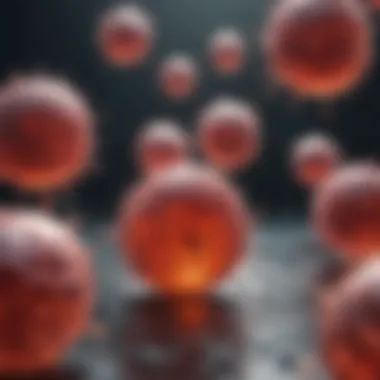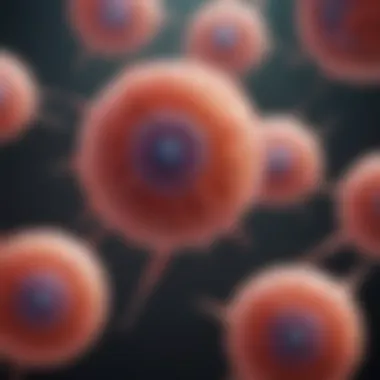CellStemCell: Advances and Insights in Stem Cell Research


Intro
Stem cell research stands at the frontier of biological sciences. Its complexity lies not only in the cellular mechanisms but also in the vast potential it holds for medical science. By exploring the various dimensions of stem cells—from their origins to their applications—we can grasp the remarkable opportunities they present for regenerative medicine. Understanding this field is crucial as it intersects a range of disciplines, emphasizing its importance in advancing healthcare.
Research Overview
Summary of Key Findings
Recent studies have unearthed significant insights into stem cell functionality. Stem cells can be categorized into two main types: embryonic stem cells and adult stem cells. Each type possesses unique properties and applications. For instance, embryonic stem cells have pluripotent capabilities, allowing them to transform into any cell type. On the other hand, adult stem cells are more limited in their differentiation potential, but they play crucial roles in tissue maintenance and repair.
Moreover, advancements in technologies such as CRISPR-Cas9 for gene editing and 3D bioprinting of tissues have opened new avenues for stem cell applications. Researchers increasingly emphasize a focus on in vivo studies to assess the actual effects of treatments derived from stem cell technologies.
Relevance to Current Scientific Discussions
The implications of stem cell research resonate within ongoing discussions regarding treatment for conditions such as Parkinson's disease, spinal cord injuries, and heart disease. As a result, this field not only impacts biological sciences but also raises significant ethical questions about the manipulation of human life.
“The ongoing balance between technological capability and ethical responsibility defines the trajectory of stem cell research.”
Ethical considerations encompass concerns about source material for stem cells, including debates on the use of fetal tissue and the moral status of embryos. These discussions are pertinent as regulatory frameworks evolve to keep pace with scientific innovation.
Methodology
Research Design and Approach
The studies in stem cell research typically adopt a multidisciplinary approach that incorporates biology, medicine, and engineering principles. This integration allows a comprehensive view of stem cell behavior and their therapeutic applications. Researchers often engage in both laboratory and clinical settings to ensure their findings are applicable to real-world scenarios.
Data Collection and Analysis Techniques
Data collection methods in this field vary widely. Researchers may collect samples through biopsies or utilize advanced imaging techniques to observe cell behavior in vitro and in vivo. Analysis often involves complex statistical techniques to ascertain the efficacy of treatments studied. Additionally, bioinformatics has become indispensable, assisting researchers in managing vast datasets related to stem cell characteristics.
Understanding these methodologies enriches the discussion about the future of stem cell research—showing it as a continually evolving discipline with both profound promise and necessary caution.
Prolusion to Stem Cells
Stem cell research stands at the forefront of modern biology, providing insights that transcend traditional boundaries in health and science. Understanding stem cells is not just about their characteristics, but also about their potential to innovate medical treatment and illuminate biological processes. This significance is further underpinned by ethical considerations and technological advancements that enhance research capabilities. By exploring stem cells, we delve into fundamental biological inquiries and practical applications that influence healthcare strategies.
Definition and Characteristics of Stem Cells
Stem cells are unique cellular entities with the capacity to develop into various cell types within the body. They are primarily defined by two critical features: the ability to self-renew indefinitely and the capacity to differentiate into specialized cell types. Embryonic stem cells are derived from the inner cell mass of a blastocyst and possess pluripotent characteristics, meaning they can become any cell type within the human body. In contrast, adult stem cells are multipotent and more limited, typically differentiated into specific lineages tied to their tissue of origin.
The intrinsic nature of stem cells is driven by specific signaling pathways and markers. To illustrate:
- Self-Renewal: This is crucial for maintaining tissue homeostasis.
- Differentiation Potential: It dictates the functional versatility of stem cells, impacting therapeutic avenues.
The understanding of these characteristics is foundational in the exploration of regenerative medicine and therapy.
History of Stem Cell Research
The journey of stem cell research traces back to the early 20th century, with notable milestones shaping its evolution. Initial observations in embryology revealed the unique capabilities of embryonic cells, gestating a foundation for future study. By the 1960s, researchers like James Thomson made pivotal strides, isolating embryonic stem cells from mice.
A landmark achievement occurred in 1998 when Thomson and his team at the University of Wisconsin isolated human embryonic stem cells. This advancement not only heightened interest but also led to controversies surrounding ethical implications. In subsequent years, the emergence of induced pluripotent stem cells (iPSCs) in 2006 marked a transforming phase. By reprogramming somatic cells, researchers opened new pathways for cellular therapy without the ethical concerns tied to embryonic cells.
Through these historical developments, stem cell research has evolved dramatically, reflecting a tapestry of scientific curiosity, ethical challenges, and groundbreaking innovations that continue to drive the field forward.


Types of Stem Cells
Understanding the types of stem cells is crucial in stem cell research. Each type possesses unique characteristics and potential that can be harnessed in various medical applications. By exploring these different types, researchers can develop targeted therapies and treatments that improve patient outcomes and address specific health issues. The benefits and considerations surrounding each type of stem cell are essential for driving innovation in the field and raising awareness about their applications.
Embryonic Stem Cells
Embryonic stem cells (ESCs) are derived from the inner cell mass of a blastocyst, an early-stage embryo formed shortly after fertilization. These cells are pluripotent, meaning they can develop into nearly any cell type in the body. This remarkable capacity for differentiation makes ESCs a valuable tool in regenerative medicine and developmental biology.
The potential applications of embryonic stem cells are vast. Researchers explore their use in treating degenerative diseases, such as Parkinson's and diabetes. However, ethical concerns surrounding the use of embryos for research purposes complicate their viability for widespread clinical use. Balancing the science with ethical implications remains a pertinent issue in the field.
Adult Stem Cells
Adult stem cells, also known as somatic stem cells, are found in various tissues throughout the body, including bone marrow, blood, and fat. Unlike ESCs, adult stem cells are typically multipotent, meaning they can only differentiate into a limited range of cell types related to their tissue of origin.
Despite this limitation, adult stem cells have shown promise in clinical therapies. For example, hematopoietic stem cells from bone marrow are used in bone marrow transplants to treat blood disorders like leukemia. The use of adult stem cells is often more accepted ethically since they can be harvested from adult tissues without significant moral concerns.
Induced Pluripotent Stem Cells
Induced pluripotent stem cells (iPSCs) are a breakthrough in stem cell research. They are generated by reprogramming somatic cells, such as skin cells, to revert them to a pluripotent state. This process allows them to take on the properties of embryonic stem cells without the ethical concerns associated with embryo use.
The ability to derive patient-specific iPSCs presents remarkable possibilities. Researchers can potentially use iPSCs for personalized medicine, where treatments are tailored to an individual’s genetic makeup. This has significant implications for drug testing, disease modeling, and regenerative therapies, pushing biomedical research in new directions.
Comparison of Different Stem Cell Types
When comparing these types of stem cells, several factors come into play, such as their sources, differentiation potential, and ethical considerations.
- Potential for Differentiation:
- Ethical Concerns:
- ESCs: Pluripotent, capable of becoming any cell type.
- Adult Stem Cells: Multipotent: limited to certain lineages.
- iPSCs: Pluripotent, similar to ESCs but derived from adult cells.
- ESCs: Higher ethical concerns due to use of embryos.
- Adult Stem Cells: Lower ethical issues; mostly accepted.
- iPSCs: Lower ethical concerns; potential to avoid embryo use.
Applications of Stem Cell Research
The applications of stem cell research are vast and pivotal in the current landscape of biological and medical sciences. This area encompasses a range of innovative solutions to some of the most pressing health issues today. Understanding these applications can provide insights into how stem cells can revolutionize patient treatment and care. From regenerative medicine to drug development, the implications of stem cell research extend beyond scientific curiosity, offering tangible benefits to society.
Regenerative Medicine
Regenerative medicine stands as a foremost application of stem cell research, aiming to restore the structure and function of damaged tissues and organs. This field focuses on harnessing the unique qualities of stem cells, particularly their ability to differentiate into various cell types. The approach involves using stem cells to repair or replace damaged tissues.
For example, in cases of spinal cord injuries or heart disease, stem cells could potentially aid in the regeneration of the affected cells. Recent studies have demonstrated the capacity of stem cells to not just restore function but also promote healing in surrounding tissues. The clinical usage of stem cells in regenerative medicine is unfolding but is hindered by challenges in ensuring effective integration and compatibility with existing body structures.
Cell Replacement Therapy
Cell replacement therapy is a prominent subset of regenerative medicine, focusing specifically on the replacement of dysfunctional or lost cells. This application has seen significant advancements, particularly in treating conditions such as diabetes, neurodegenerative diseases, and blood disorders.
In diabetes, for instance, researchers are exploring how to turn stem cells into insulin-producing beta cells. Successful implementation could mitigate or even reverse the disease. Similarly, in Parkinson's disease and similar conditions, efforts are underway to replace lost neurons, which could restore motor function and improve quality of life.
Despite optimism, this therapy faces hurdles such as immune rejection and ethical concerns regarding source cells, especially when embryonic stem cells are involved. Ongoing research is focused on developing techniques that minimize these issues.
Stem Cells in Disease Modeling
Stem cell research is also instrumental in disease modeling, providing a platform to study various diseases at a cellular level. By creating patient-specific cell lines, researchers can observe how diseases progress, which helps in understanding the underlying mechanisms.
Having access to a diverse array of stem cell types allows for the examination of disease behavior under controlled laboratory conditions. This, in turn, aids in identifying potential therapeutic targets. For example, neurologists can use induced pluripotent stem cells from patients with Alzheimer’s disease to explore neuronal connections and pathology.


This area of research not only enhances knowledge but also facilitates the development of more personalized treatment strategies tailored to individual responses.
Potential in Drug Development
The potential that stem cells offer in drug development cannot be overstated. By using stem cells in the early stages of drug screening, researchers can better understand how new drugs affect cells. This application allows for testing on specific cell types that represent various diseases, thus improving the predictive power of preclinical models.
This streamlined approach can decrease time in drug discovery and enhance safety assessments in humans. For instance, testing for toxicity using human-derived stem cells may provide more accurate safety profiles than traditional animal models. The integration of stem cell technology into pharmaceutical processes signals a shift towards more effective and humane drug development practices.
"Stem cell applications are rapidly evolving, presenting dynamic solutions to persistent health challenges."
The significance of stem cell research is evident in its multifaceted applications across various medical fields. As technology advances and ethical considerations evolve, the future promises even more innovative approaches to harnessing the potential of stem cells. Each application not only demonstrates the versatility of stem cells but also reinforces their importance in transforming how we approach health care and disease management.
Ethical Considerations in Stem Cell Research
The realm of stem cell research carries profound ethical implications that merit careful scrutiny. This section elucidates important ethical concerns tied to the use of stem cells, especially those sourced from embryos. The discussion aims at understanding not just the scientific advancements, but also the moral responsibilities that accompany them. Addressing these ethical dilemmas ensures that stem cell research can proceed in ways that align with societal values and human dignity.
As we explore the nuances of ethical considerations in stem cell research, it becomes apparent that ethical guidelines are crucial. They serve as frameworks aimed at regulating research conduct, protecting human subjects, and guiding the application of these powerful scientific tools. Here, we will dive into two pivotal aspects: the ethical dilemmas associated with embryonic stem cell research and the regulatory frameworks designed to provide guidance and oversight.
Ethical Dilemmas of Embryonic Stem Cells
Embryonic stem cells are obtained from early-stage embryos, typically four to five days old, raising significant ethical concerns. The primary dilemma arises from the question of when life begins and whether the destruction of embryos for research is morally acceptable. Opponents argue that embryos should be afforded moral status similar to that of human beings, leading to calls for stringent restrictions on embryonic research.
Additionally, there's a concern about informed consent. Donors must fully understand the implications of donating embryos for research. It requires transparency and a commitment to ethical practices in acquiring such materials.
Some key points in this debate include:
- The potential for life created during the embryonic stage.
- The moral implications of using embryos for research.
- The need for alternatives, such as the use of adult or induced pluripotent stem cells, which do not involve embryos.
"The ethical debates surrounding embryonic stem cells are critical, shaping the future of medical research and innovation."
Regulatory Frameworks and Guidelines
To navigate the ethical landscape, various regulatory frameworks have been established internationally. These guidelines are designed to protect human rights while promoting scientific advancement. Organizations like the National Institutes of Health (NIH) and the International Society for Stem Cell Research (ISSCR) have developed comprehensive guidelines aimed at ensuring ethical standards are met in stem cell research.
Important components of these regulations often include:
- Informed consent: Ensuring donors understand the implications of their contributions.
- Oversight committees: Established to review and approve research proposals involving human embryos.
- Public transparency: Making research objectives and processes clear to stakeholders and the public.
These frameworks serve not just to mitigate risks but also to enhance public trust in scientific inquiry. Overall, a balanced approach that weighs ethical considerations against the potential benefits of stem cell research is essential to achieving progress in this transformative field.
Recent Technological Advancements
Recent technological advancements are reshaping the landscape of stem cell research. This section emphasizes the key developments that enhance our understanding and application of stem cells. These advancements hold significant potential to transform therapeutic strategies and improve patient outcomes.
CRISPR and Gene Editing
CRISPR technology has revolutionized genetic engineering in recent years. It allows for precise modifications in the DNA of stem cells. This precision ensures targeted edits, which provides great benefits in correcting genetic defects.
- Precision: Researchers can make specific changes at chosen sites in the genome. This reduces unintended consequences.
- Efficiency: CRISPR can enhance the efficiency of generating genetically modified stem cells.
- Versatility: It is applicable to different cell types, making it a powerful tool across various research fields.
However, ethical considerations arise. There are concerns about off-target effects, where CRISPR might edit unintended parts of the genome. Researchers must navigate these challenges carefully to maintain the integrity of their studies.
3D Bioprinting Technologies
3D bioprinting has emerged as a revolutionary method in tissue engineering, utilizing stem cells for creating complex tissue structures. This technology enables precise placement of stem cells and associated biomaterials. Some notable aspects include:


- Complexity: It allows for the production of tissues that mimic natural biological structures.
- Customization: Researchers can personalize tissues based on specific patient needs. This personalization can enhance the success of transplants and other therapies.
- Speed: 3D bioprinting significantly accelerates the creation of tissue models for research and testing.
The ability to create functional tissues promises advancements in regenerative medicine. Nevertheless, scalability and reproducibility continue to be areas that require focus.
Stem Cell Banking and Preservation
Stem cell banking is a crucial aspect of stem cell research. It ensures the availability of high-quality stem cells for future research and therapeutic use. Some key points regarding stem cell banking include:
- Long-term Storage: Stem cells can be preserved for extended periods through cryopreservation techniques. This allows researchers to access vital resources when needed.
- Quality Control: Rigorous quality assessments ensure that the stored stem cells maintain their viability and functionality over time.
- Diverse Sources: Banking facilities can provide stem cells from various sources, such as umbilical cord blood and adult tissues, facilitating a wide range of research applications.
Stem cell preservation also introduces discussions around accessibility and ethical sourcing. As more individuals engage in banking, addressing these aspects becomes paramount.
"The future of stem cell research hinges on our ability to embrace and advance technological innovation."
These technological insights are mere glimpses into an evolving field. Continuous exploration is necessary as we push the boundaries of what stem cells can achieve.
Challenges in Stem Cell Research
Stem cell research is at the forefront of modern biomedical science, offering potential solutions to numerous medical challenges. However, there are significant challenges that hinder its progress. Understanding these challenges is crucial for anyone involved in or studying the field.
Technical and Biological Hurdles
One major challenge stems from the complexity of stem cells themselves. These cells possess unique properties that make them difficult to manipulate and study in laboratory settings. For instance, culturing stem cells often presents issues, such as maintaining their pluripotency and preventing unwanted differentiation. This demands advanced techniques and highly controlled environments.
Moreover, technical issues arise in the integration of stem cells into existing tissues. When injected, stem cells may not differentiate into the desired cell type, or they might fail to integrate properly. This unpredictability poses a significant barrier to their application in therapies.
Additionally, the variability between different stem cell lines contributes to inconsistent results. Factors such as genetic background, culture conditions, and prior manipulation can affect outcomes. Therefore, researchers must establish standardized protocols to ensure reproducibility and reliability of results.
"The technical and biological hurdles represent not only scientific challenges but also significant barriers to clinical application."
Public Perception and Misinformation
The public's understanding of stem cell research often lags behind scientific advances. Misconceptions about stem cells, particularly regarding their origin, create substantial barriers. Many individuals associate embryonic stem cells solely with ethical debates, overshadowing the advancements made in adult and induced pluripotent stem cells.
Misinformation can spread rapidly, often fueled by media portrayals or anecdotal experiences. This might lead to unrealistic expectations of stem cell treatments, which can be harmful. For example, some individuals might opt for unproven therapies marketed as miraculous cures, risking their health and finances.
Efforts to communicate effectively about stem cell research are vital. Scientists and educators should engage with the public, providing clear and accurate information to dispel myths. Better understanding can foster support for continued research and funding, essential for overcoming the existing hurdles.
In summary, addressing the challenges in stem cell research is critical for its advancement. Both technical and biological hurdles must be tackled with robust research methodologies, while improving public perception through education and transparency is equally important. Only then can the full potential of stem cell research be realized.
Future Directions in Stem Cell Research
The realm of stem cell research is evolving rapidly. As the scientific community continues to explore the full potential of stem cells, future directions offer significant promise and complexities. Understanding these advancements is crucial for researchers, educators, and healthcare professionals. They shape both theoretical frameworks and practical applications in regenerative medicine. Recent breakthroughs not only highlight the versatility of stem cells but also raise important considerations about ethical implications, funding, and public perception.
Innovations on the Horizon
Recent advancements in stem cell technology provide exciting breakthroughs. For example, direct conversion techniques have emerged. Scientists can now convert one type of cell into another without going through the pluripotent stage. This could streamline the process of generating specific cell types for therapy. Additionally, CRISPR gene-editing technology is paving the way for genetic modifications in stem cells.
- Improved Disease Models: Human-derived stem cells allow the creation of complex models for diseases such as Alzheimer's and diabetes, improving our understanding of these conditions.
- Patient-Specific Therapies: The potential for creating personalized stem cell therapies arises. This means one could derive stem cells from a patient’s own cells, minimizing rejection risks.
- 3D Bioprinting: Rapid advancements in 3D bioprinting are revolutionizing the production of tissues and organs. Combining bioprinting with stem cells may enable the creation of fully functional organs for transplantation.
Collaborative Efforts in Science
As the field matures, collaboration becomes essential. Interdisciplinary studies that bring together biologists, ethicists, engineers, and clinicians promote a holistic approach to stem cell research. Such partnerships foster creativity, leading to innovative solutions in therapy and research methodologies.
- Public-Private Partnerships: Companies and research institutions are increasingly partnering. This collaboration not only attracts diverse funding sources, but also accelerates the translation of research into viable treatments.
- International Research Networks: Global collaboration helps harmonize research efforts across countries. This sharing of data can enhance the quality and impact of the findings, while also ensuring that diverse patient populations are considered.
"The future of stem cell research is not just about scientific breakthroughs; it's about how these advances can be effectively translated into clinical practice and patient benefit."
These rich collaborative environments create platforms for sharing best practices, data, and resources. Engaging with different viewpoints challenges existing paradigms and fosters thoughtful discussions about ethical issues.
In summary, the future directions of stem cell research encompass a wide array of innovations and collaborative efforts. They offer the potential to transform medical treatments and improve lives. As research progresses, it is essential to maintain a balance between technological advancements and ethical considerations.



